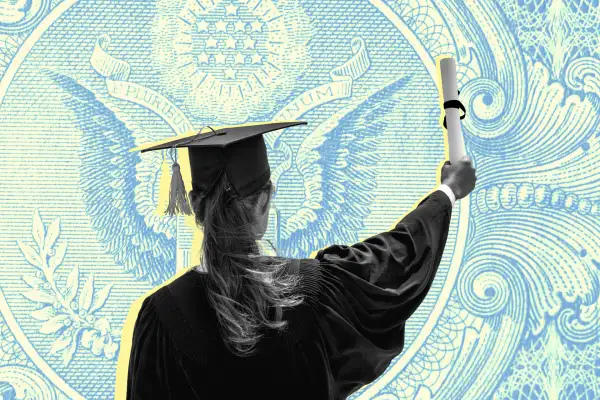Here's How Much Student Loan Borrowers Will Owe When Payments Restart

Federal student loan payments are set to restart this spring, and how much the typical borrower still owes may be surprising: It's a little under $19,000, according to a new government report.
For more than two years now, student-loan borrowers with federal “Direct” loans — the most popular type of student loan — have enjoyed an automatic moratorium on loan payments. Meanwhile, the interest rates on those loans have remained at zero, all thanks to emergency legislation aimed at curbing the economic effects of the pandemic and five subsequent extensions to the student-debt relief portion.
Unless the program is extended for a sixth time — or federal student loan debt gets canceled somehow — that relief will end May 1.
“Nearly 37 million borrowers have not been required to make payments on their student loans since March 2020, resulting in an estimated $195 billion worth of waived payments through April 2022,” researchers for the Federal Reserve Bank of New York wrote in a report released Tuesday.
In the report, researchers broke up the amount of money that borrowers owe into three loan categories:
- Federal Direct loans, which the overwhelming majority of borrowers hold
- Private student loans from various private lenders
- Federal Family Education Loans (FFEL), a popular but defunct federal program that guaranteed loans through commercial lenders
The first category of loan is the only one that was automatically eligible for the student loan moratorium put in place in March 2020.
According to the NY Fed, the median amount owed by a federal student loan borrower is $18,733.
Of course, this entire amount won't be due all at once, but monthly payments are slated to restart soon. For context, the typical monthly payment for student loan borrowers is approximately $222, according to a separate study from the Federal Reserve.
Overall, Direct federal student loans represent the vast majority of all student loan debt, accounting for $1.3 trillion of the $1.7 trillion student-loan debt total.
Federal student loan borrowers at risk
When or if the time comes for federal Direct student loan payments to resume, researchers say borrowers will be at an increased risk of falling behind on their debt payments — and not just their student loan payments.
“We believe that Direct borrowers are likely to experience a meaningful rise in delinquencies, both for student loans and for other debt, once forbearance ends,” the researchers wrote in the report.
That’s due, in part, because federal Direct loan borrowers typically have lower credit scores and larger amounts of student-loan debt than borrowers with private student loans.
Credit scores and debt owed by student loan borrowers
Here’s how federal Direct loan borrowers compare to private-loan borrowers:
- Credit score: Direct loan borrowers have a median credit score of 654, compared to a score of 713 for typical private loan borrowers.
- Age: The typical Direct loan borrower is 33 years old, whereas the median age for private student loan borrowers is 39.
- Outstanding debt: The median balance for Direct loan borrowers is $18,773; private loan borrowers have a median balance of $14,087.
For reference, the credit bureau Experian says the average credit score for 30-somethings is about 667, and the overall average is 695. The NY Fed's report suggests the typical federal student loan borrower has a below-average credit score, and the typical private loan borrower has an above-average one.
It's also important to keep in mind that, while $19,000 of student loan debt per borrower may appear low, the NY Fed is accounting for all student debt. High five-figure and even six-figure student debt often make headlines, but these figures typically only look at debt for college graduates with bachelor's or master's degrees.
The NY Fed's data includes certificate programs and associate's degrees, as well as the debt for borrowers who didn't complete their program. While this type of debt affects a larger number of borrowers, it also brings the median and debt-per-borrower total down.
Will there be another student loan forbearance extension?
With less than 40 days to go until the latest student loan forbearance extension expires, some lawmakers have been urging President Biden to provide more relief — ranging from extending the moratorium yet again to outright canceling federal student debt.
Recently, the three major credit bureaus — Experian, Equifax and TransUnion — announced they will exclude most medical debt from their credit reports. Some policymakers are calling for similar treatment for student loan debt, which would provide some relief but is far from a panacea.
“Suspending the reporting of delinquencies will certainly prevent payment difficulties from appearing on a borrower’s credit report and allow borrowers to better ease into repayment,” the NY Fed researchers wrote, “but these repayment issues will still exist under the surface.”

